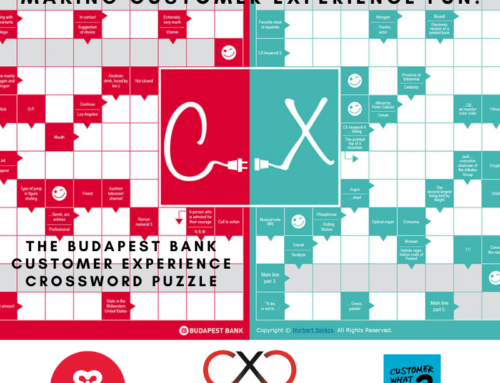
If you have ever heard me speak, or read something I have ‘penned’, you will know that I am a huge believer in the application of the ‘science’ of customer experience – an understanding of; and the ability to apply; the competencies that sit behind the profession that customer experience has become.
Customer journey mapping is one of the competencies that comprise the science – yet it is a competency that has been applied around the world with varying levels of success. My biggest concern is not in understanding what it is, but in knowing what to do with it!
That is why I am delighted to announce that I am partnering with a brilliant technology company to help turn the journey map into the ‘living breathing organism for change’ that it needs to be. Together with my friends at CEMantica, we have created two blog posts to explain how customer journey mapping CAN drive real, demonstrable change and tangible benefit to an organisation. I hope you enjoy the first of the two articles posing the question – are ‘static’ maps a waste of time and money?……
Before I get started let’s take a second and make sure we’re not “journeying” into uncharted territory! So here it goes. What exactly is a static customer journey map?
A customer journey map is a visualisation of the process that a person goes through in order to accomplish a goal – in other words, it is a visual representation of everything a customer interacts with in their relationship with an organisation. For a business, that translates into “mapping” the experiences of potential and existing customers. Some parts of the route are a smooth ride – others are can be a nightmarish obstacle course!
Ok – so now I can tick off exactly what a journey map is, but what do I mean by a ‘static’ journey map? Allow me to continue…..
The power of a customer journey map!
Imagine knowing what makes your customers tick. Imagine understanding their ulterior motives. Imagine getting so close to your customers that you become their business ‘soulmates’. Imagine actually learning why they pick your brand over another. Besides sounding like John Lennon, there’s a real takeaway here! The takeaway is that it is absolutely possible to do all of those things!
Yes, you can get to know your customers, anticipate and exceed their expectations and keep them coming back for more; you gain customer stickiness; loyalty; and even advocacy. The ultimate success story scenario.
So how is this done? How do we get to know our customers and understand their needs, let alone anticipate their needs?
Leaders in the field of customer experience have said it, done it and proved it – a critical component of customer experience management is to MAP and MANAGE the customer journey. In other words it is critical to visualise where and how your customers interact with your brand. The mapping process allows you, as a company, to put yourself in your customers’ shoes on the other side of the ‘counter’, so to speak.
What does Customer Experience mean and how does it affect Customer Journey Mapping?
The customer experience (CX) essentially represents how customers perceive their interactions with your company. CX is a representation of the sum of all the interactions a customer has with an organisation through their entire life cycle. It stretches from well before they became a customer of your goods or services, from the awareness phase, right up to getting them to come back and purchase again.
To be able to understand how to better meet the needs and expectations of customers over time, we MUST understand the customer’s life cycle with your company AND how they feel when they interact with you. In other words, at risk of repeating myself, we MUST understand what the customer journey looks like – we must be able to create a customer journey map. Customer journey mapping, is, as a result, a very important competency within the field of customer experience management.
What does customer journey mapping look like?
Like any reporting tasks nowadays, you can always go for the traditional – reporting static figures on spreadsheets that often look at the past, not the future – or you could decide to take it a step further. You can say I’m a dreamer, oops John Lennon again (chorus)… but technology today can take you to a whole new level strengthening your approach to CX strategy while giving you a serious competitive edge.
So when it comes to customer journey mapping, let’s understand why the traditional or manual way of mapping a customer’s journey in this digital era has become a significant issue.
Pens out; multicoloured sticky notes in hand; whiteboard or A3 sheets of paper pinned to the wall; and you’re ready to roll! Cross functional teams, brainstorming galore, to map the journey. This traditional approach has enabled thousands of organisations to ‘lay it all out’, bringing the customer story to life and visualise the so called “ah-ha” moments where executives realise what steps their customers have been taking to complete a specific action.
The mapping process puts things into perspective. Once you have understood who you are mapping the journey for (Persona), what the different steps are (Stages) and defined their experiences along the way, you have yourself a complete journey map.
Deriving more value from a customer journey map
But data is only “oh-so valuable” if you can actually drive insights from it – in other words, leverage the data into actionable insights to make informed decisions and adjust strategies.
This is one of the reasons why I have been ‘preaching’ for a long time now about the importance of customer journey MANAGEMENT – a series of interconnected and continuous activities, to ever improve the ability of the journey to meet the needs and expectations of customers.

Too many organisations around the world have mapped their customer journeys once – and never looked at them again. They have created a ‘static’ map – that often looks very pretty – but that is not used continuously to understand how to dynamically improve the customer experience.
Let’s say for example, that while you were mapping the journey you came to realise that it takes your customer 10 extra unnecessary steps to reach your customer service team; how is that for FRUSTRATION? – you’re going to want to change that right? Right!
Well this is where we find the difference between the STATIC and the DYNAMIC – we either stare at the information and scratch our heads to figure out what to do, or we have a way of converting our understanding of the data into actionable insights.
We have reached the limits of what a static map can yield in terms of business value. You have invested a considerable amount of time, energy and resources in creating this map, but you have no way of capitalising on all of this investment and making it last and evolve. So yes, start by mapping the journey on a wall if it helps to kick off the process, but there definitely needs to be a next step – mapping the journey is only one part of MANAGING the journey.
Make sure to tune in to my next article where I’ll be explaining THE solution to this problem/dilemma: Dynamic Customer Journey Maps!!!
CEMantica is a customer-centric company that helps you build a memorable connection with your customers engaging them with your brand. Their proven CX approach combined with their innovative technologies deliver compelling insights to help you:
- Identify your customers’ pain points, areas of improvement, new growth paths
- and take immediate and tailored actions within your organisation
CEMantica’s comprehensive end-to-end value proposition, from CX assessment to Customer Journey Mapping and solution roll out, is your “customer experience ready” enablement model.
Meet the team behind CEMantica:
Julia Perez
Sales Manager at CEMantica Ltd. With a passion for CX, a thorough experience in digital Marketing and online social media presence, Julia thrives to develop the business of dynamic digital journey maps on the market and help customers transform journey data into actionable insights.
Eytan Hattem
Chief Innovation & Business Solutions Officer at Prodware Group. With over +20 years of experience in customer engagement technology implementations and customer experience consulting, Eytan is driving the international CX practice of Prodware worldwide.
Prodware Group
Prodware Group, founded in 1989, is a creator and integrator of industry and role-based solutions. Prodware is Microsoft’s leading partner in the EMEA offering a comprehensive value proposition around business application that combines consulting services, implementation services and managed services on an international scale.
“We help our customers step into the future by building the business processes of tomorrow”






Leave A Comment